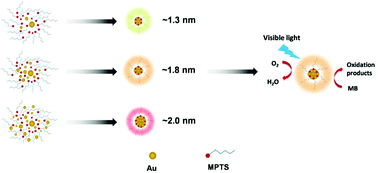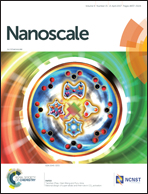Fluorescent Au nanoclusters stabilized by silane: facile synthesis, color-tunability and photocatalytic properties†
Abstract
Synthesis of tunable, luminescent metal nanoclusters remains challenging due to their tendency to aggregate. Herein, we report a simple photoreduction method to synthesize fluorescent silane-stabilized Au nanoclusters. By altering the molar ratio of stabilizer and Au precursor, emissions of the as-prepared Au nanoclusters can be tuned in the wavelength range of 538–580 nm. High resolution transmission electron microscopy results showed that the variation in the size of the as-formed nanoclusters (1.2–2.0 nm) might be responsible for this emission shift. The as-synthesized gold nanoclusters have a relatively long fluorescence lifetime, from 34.04 to 46.83 ns, and luminescence quantum yields of 0.26–3.16%, depending on the fluorescence at the specific emission wavelength. Compared with bulk gold, these silane-stabilized Au nanoclusters possess special electronic structures and exhibit semiconductor-like features such as an absorption edge in the visible region, which gives rise to their visible excitation at 400–450 nm. As demonstrated by the degradation of methylene blue under visible irradiation, the synthesized Au nanoclusters can also function as a promising cluster photocatalyst, just like many other semiconductor counterparts.



 Please wait while we load your content...
Please wait while we load your content...